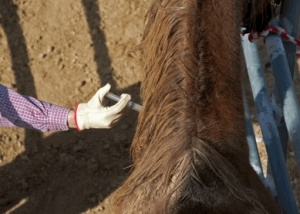Drug Use
The use of drugs in horse racing is extremely common. With so much at stake, trainers will do almost anything to give their horse an advantage without considering the welfare of the horse.
Stimulants are used to give a horse extra temporary energy. Pain relieving drugs are used to mask pain that may result from disease or injury. Certain drugs can also be used to control pulmonary bleeding (EIPH) resulting from over-exertion in racing.
 Certain drugs are even used to make the horse run slower thereby manipulating the form of the horse.
Certain drugs are even used to make the horse run slower thereby manipulating the form of the horse.
While using certain drugs under the rules of racing is permitted, the question which needs to be asked is, ‘is this in the best interest of the horse?’ In most cases the answer is no.
Pain and fatigue are warning signs to slow down. If masked by drugs, it can lead to serious injuries and it often does, especially when combined with the threat of the whip.
The general rule is that on the day of racing, all horses must be clean of any prohibited substances though they may be used in training. As literally hundreds of different drugs are developed each year, it is extremely difficult for them to be detected.
Some common drugs
Anabolic Steroids
Have been used in horse racing in the same way as they have been used by athletes. Steroids enhance muscle development but as they are now easily detected have fallen out of favour to other drugs.
Etorphine
(Elephant juice). A tranquiliser for large animals such as elephants, it can be a most powerful stimulant if applied correctly to horses.
Narcotic Analgesics
Used for pain relief, however in small doses are a powerful stimulant.
Caffeine
A noted stimulant popular for many years but now very easily detected.
Beta Blockers
Are used to slow the heart rate in horses thereby manipulating the horses performance.
Butazolidin
Has pain-killing and anti-inflammatory properties, which means a horse with congenital defects or soreness due to injury will perform better.
Bicarb
In large doses can “mop up” the lactic acid that comes with muscle activity. Commonly known as a milkshake, it allows the horse to sustain a run for longer. It is a very common practice with as much as 600 grams being administered in a single dose. Trainers often would administer a spoonful to a horse each day to help with their recovery after hard work. More recently, tubing has become the norm as it ensures every bit of the solution reaches the horse’s stomach. A bicarb (TCO2) stomach drench is popular with many trainers as it has been found that bicarb helps buffer lactic acid. As bicarb is naturally produced, it cannot be banned entirely. Instead, there is a threshold level of 36 millimoles a litre plasma total carbon dioxide. Any reading over that constitutes an offence.
Blue Magic
Also known as propantheline bromide. It is used to help relax muscles, which leads to increased blood flow. No traces of the drug have been found in thoroughbred racing but several leading harness racing figures have been charged with its use.
Reference: The Drugs Challenge, The Age December 28, 2004 by Andrew Eddy

